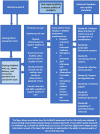Monitoring healthcare improvement for mothers and newborns: A quantitative review of WHO/UNICEF/UNFPA standards using Every Mother Every Newborn assessment tools
- PMID: 36172396
- PMCID: PMC9510702
- DOI: 10.3389/fped.2022.959482
Monitoring healthcare improvement for mothers and newborns: A quantitative review of WHO/UNICEF/UNFPA standards using Every Mother Every Newborn assessment tools
Abstract
Background: Assessment tools with the ability to capture WHO/UNICEF/UNFPA standard quality-of-care measures are needed. This study aimed to assess the ability of Every Mother Every Newborn (EMEN) tools to capture WHO/UNICEF/UNFPA maternal and newborn quality improvement standard indicators.
Methods: A quantitative study using the EMEN quality assessment framework was applied. The six EMEN tools were compared with the WHO/UNICEF/UNFPA maternal and newborn quality improvement standards. Descriptive statistics analysis was carried out with summaries using tables and figures.
Results: Overall, across all EMEN tools, 100% (164 of 164) input, 94% (103 of 110) output, and 97% (76 of 78) outcome measures were assessed. Standard 2 measures, i.e., actionable information systems, were 100% (17 of 17) completely assessed by the management interview, with 72% to 96% of standard 4-6 measures, i.e., client experiences of care, fulfilled by an exit interview tool.
Conclusion: The EMEN tools can reasonably measure WHO/UNICEF/UNFPA quality standards. There was a high capacity of the tools to capture enabling policy environment and experiences of care measures not covered in other available tools which are used to measure the quality of care.
Keywords: assessment tools; childbirth; healthcare improvement; measures; monitoring; standards; statements.
Copyright © 2022 Siseho, Mathole and Jackson.
Conflict of interest statement
The authors declare that the research was conducted in the absence of any commercial or financial relationships that could be construed as a potential conflict of interest.
Figures




References
-
- WHO/UNICEF. Ending Preventable Newborn Deaths and Stillbirths: Moving Faster Towards High-Quality Universal Health Coverage in 2020-2025. New York, NY: UNICEF; (2020).
-
- WHO/UNICEF/UNFPA. Quality, Equity, Dignity: The Network to Improve Quality of Care for Maternal, Newborn and Child Health - Strategic Objectives Geneva, Avenue Appia20, 1211. Geneva: World Health Organisation; (2018).
-
- WHO/UNICEF/UNFPA. Standards for Improving Quality of Maternal and Newborn Care in Health Facilities. Avenue Appia 20, CH-1211. Geneva: World Health Organisation; (2016). 84 p.
LinkOut - more resources
Full Text Sources

